Tuesday, May 11th 2021

Intel Announces 11th Gen Core "Tiger Lake-H" Mobile Processors
Intel today announced the 11th generation Core "Tiger Lake-H" mobile processors for notebooks of conventional thickness, gaming notebooks, and mobile workstations. This is the first scale-up of the "Tiger Lake" microarchitecture, with the introduction of a brand new die that has up to 8 "Willow Cove" CPU cores. These processors typically come with TDP of 35-45 W, but the flagship part ships with TDP as high as 65 W. Unlike "Rocket Lake," this chip is built on Intel's latest 10 nm SuperFin silicon fabrication process. With it, Intel is announcing ten processor SKUs—five each for the consumer and commercial notebook market segments. These span across the Core i9, Core i7, and Core i5 brand extensions.
The 10 nm "Tiger Lake-H" silicon measures roughly 190 mm², and has several changes compared to the 4-core "Tiger Lake-U" silicon the company debuted the 11th Gen with. The biggest change is the CPU core count of 8. This lets it not only achieve parity with AMD in mobile CPU core counts, but also purportedly beat it on the back of a higher IPC. Each of these 8 "Willow Cove" cores has 1.25 MB of dedicated L2 cache, and share 24 MB of L3 cache. You get the same "Willow Cove" ISA as the "Tiger Lake-U," including AVX-512 and DLBoost. Next up, the chip features an integrated graphics based on the Gen12 Xe LP graphics architecture, only that the execution units have reduced to just 32 on this silicon, compared to 96 on the 4-core Tiger Lake-U. The new chip enjoys a bigger power budget to run the iGPU at higher clock speeds. There is also a 20-lane PCI-Express Gen 4.0 interface, and a dual-channel DDR4 memory controller.From the five consumer SKUs, four are 8-core/16-thread, and two 6-core/12-thread. Leading the pack is the Core i9-11980HK, targeted exclusively at gaming notebooks. This chip ticks at 3.30 GHz (nominal), and can boost up to 5.00 GHz, with up to 1.45 GHz iGPU frequency. The chip is also unlocked, and has many of the same overclocking features as the desktop Core i9-11900K. Next up in the Core i9 series is the i9-11900H, with much lower 2.50 GHz nominal clocks, but up to 4.90 GHz boost, and the same 1.45 GHz iGPU clocks. The Core i9 parts feature Turbo Boost Max 3.0 boosting algorithm.The Core i7 series are differentiated from the Core i9 with an apparent lack of Turbo Boost Max 3.0. These are still 8-core/16-thread chips with the full 24 MB of L3 cache. The Core i7-11800H is clocked at 2.30 GHz with 4.60 GHz max boost. Next up are the 6-core/12-thread Core i5 series, which surprisingly feature just 12 MB of L3 cache (and not the expected 18 MB, going by the 3 MB/core convention for Tiger Lake). The Core i5-11400H is clocked at 2.70 GHz, with up to 4.50 GHz boost, while the i5-11260H does 2.60 GHz with up to 4.40 GHz boost. Both these feature lower 1.40 GHz max iGPU clocks. It's interesting to note here, that Intel isn't branding the Xe LP iGPU under the Iris Xe series, but rather the UHD 750 series.The commercial SKUs are available only in notebooks that are sold in bulk to large corporations. These include the Core i9-11950H, the i7-11850H, and the i5-11500H, which each feature about 100-200 MHz higher clocks than the i9-11900H, i7-11800H, and the i5-11400H, respectively. There's also the addition of the Xeon W-11955M and the Xeon W-11855M, which feature ECC memory support. All these commercial SKUs feature Intel vPro, Trusted Execution technology, and SIPP. The commercial chips also feature Intel CET (control-flow enforcement technology), which thwarts a class of side-channel attacks; and the Threat Detection Technology (silicon-based AI threat detection).As for performance, Intel claims to have comprehensively beaten the previous-generation Core i9-10980HK "Comet Lake-H," as well as the AMD Ryzen 5900HX "Zen 3" processor, claiming significant gaming performance gains, as well as CPU performance gains in the near double-digits, based the higher IPC of "Willow Cove," combined with core-count parity, and a lavish power budget to go with the 10 nm SuperFin process.The platform and I/O has a handful improvements. You get PCI-Express 4.0 x16 graphics, and a CPU-attached PCI-Express 4.0 x4 for an M.2 NVMe slot. The x16 slot can be further segmented into x8/x4/x4 or even x12/x4, so additional CPU-attached M.2 slots can be created for NVMe RAID, or for CPU-attached Thunderbolt 4 controllers. DDR4-3200 is natively supported, although notebook vendors have the freedom to push memory frequencies higher. The chipset bus has been fattened, and is DMI 3.0 x8 (physically PCI-Express 3.0 x8). The 24 lanes put out by the chipset are Gen 3. Besides Thunderbolt 4 (40 Gbps), the I/O includes MIPI SoundWire audio, Optane H20, Wi-Fi 6E (Gig+), and 2.5 GbE wired networking.
The complete slide deck follows.The press-release follows.
Intel delivers industry-leading mobile performance with 11th Gen Intel Core mobile H-series and Intel Xeon W-11000 series
The new 11th Generation Intel Core H-series mobile processors (code-named "Tiger Lake-H") launched worldwide today, led by the flagship Intel Core i9-11980HK—the "World's Best Gaming Laptop Processor."1 The Intel Core i9-11980HK delivers the highest-performance in laptops for gaming, content creators and business professionals reaching speeds of up to 5.0 gigahertz (GHz).
"11th Gen Intel Core H-series processors take mobile gaming, content creation and commercial workstation systems to new heights. These new H-series processors are an exciting extension of our 11th Gen mobile family with double-digit single core and multi-core performance improvements, leading gameplay, direct attached storage and 20 PCIe 4.0 lanes for true enthusiast-level platform bandwidth. 11th Gen H-series is the industry's most performant mobile processor that empowers users to game, create and connect with leadership performance at any enthusiast form factor."—Chris Walker, Intel corporate vice president and general manager of the Mobile Client Platforms Group.
With new 11th Gen Intel Core H-series processors, Intel leverages deep expertise in advanced processor design and PC gaming to bring the world's best gaming laptop processors to gamers around the globe.
Extending the performance momentum established by the 11th Gen Intel Core H35 series, the 11th Gen Intel H-series processors, based on 10 nanometer SuperFin process technology, feature up to 8 cores and 16 threads, with single and dual-core turbo performance up to 5.0 GHz. Additionally, the central processing unit (CPU) can directly access high-speed GDDR6 memory attached to the graphics card, enabling gamers to experience higher framerates with lower latency, and load large textures faster. The mobile processor offers 2.5 times the total PCIe bandwidth to the CPU compared with the 10th Gen H-series processors, and three times the total PCIe bandwidth compared with other industry processors.
11th Gen Intel Core H-series mobile processors empower creators and business professionals to execute tasks faster, from anywhere, thanks to best-in-class components and connectivity 3. With 20 lanes of PCIe Gen 4—a first for any laptop—the processor offers 4K HDR/Dolby Vision video streaming, rich configurations with fast storage, hybrid Intel Optane for high performance and capacity, 6GHz Intel Killer Wi-Fi 6E (Gig+) support, and Thunderbolt 4 with up to 40 gigabytes (GBs) per second for faster connections.
New platform features also include:
The 10 nm "Tiger Lake-H" silicon measures roughly 190 mm², and has several changes compared to the 4-core "Tiger Lake-U" silicon the company debuted the 11th Gen with. The biggest change is the CPU core count of 8. This lets it not only achieve parity with AMD in mobile CPU core counts, but also purportedly beat it on the back of a higher IPC. Each of these 8 "Willow Cove" cores has 1.25 MB of dedicated L2 cache, and share 24 MB of L3 cache. You get the same "Willow Cove" ISA as the "Tiger Lake-U," including AVX-512 and DLBoost. Next up, the chip features an integrated graphics based on the Gen12 Xe LP graphics architecture, only that the execution units have reduced to just 32 on this silicon, compared to 96 on the 4-core Tiger Lake-U. The new chip enjoys a bigger power budget to run the iGPU at higher clock speeds. There is also a 20-lane PCI-Express Gen 4.0 interface, and a dual-channel DDR4 memory controller.From the five consumer SKUs, four are 8-core/16-thread, and two 6-core/12-thread. Leading the pack is the Core i9-11980HK, targeted exclusively at gaming notebooks. This chip ticks at 3.30 GHz (nominal), and can boost up to 5.00 GHz, with up to 1.45 GHz iGPU frequency. The chip is also unlocked, and has many of the same overclocking features as the desktop Core i9-11900K. Next up in the Core i9 series is the i9-11900H, with much lower 2.50 GHz nominal clocks, but up to 4.90 GHz boost, and the same 1.45 GHz iGPU clocks. The Core i9 parts feature Turbo Boost Max 3.0 boosting algorithm.The Core i7 series are differentiated from the Core i9 with an apparent lack of Turbo Boost Max 3.0. These are still 8-core/16-thread chips with the full 24 MB of L3 cache. The Core i7-11800H is clocked at 2.30 GHz with 4.60 GHz max boost. Next up are the 6-core/12-thread Core i5 series, which surprisingly feature just 12 MB of L3 cache (and not the expected 18 MB, going by the 3 MB/core convention for Tiger Lake). The Core i5-11400H is clocked at 2.70 GHz, with up to 4.50 GHz boost, while the i5-11260H does 2.60 GHz with up to 4.40 GHz boost. Both these feature lower 1.40 GHz max iGPU clocks. It's interesting to note here, that Intel isn't branding the Xe LP iGPU under the Iris Xe series, but rather the UHD 750 series.The commercial SKUs are available only in notebooks that are sold in bulk to large corporations. These include the Core i9-11950H, the i7-11850H, and the i5-11500H, which each feature about 100-200 MHz higher clocks than the i9-11900H, i7-11800H, and the i5-11400H, respectively. There's also the addition of the Xeon W-11955M and the Xeon W-11855M, which feature ECC memory support. All these commercial SKUs feature Intel vPro, Trusted Execution technology, and SIPP. The commercial chips also feature Intel CET (control-flow enforcement technology), which thwarts a class of side-channel attacks; and the Threat Detection Technology (silicon-based AI threat detection).As for performance, Intel claims to have comprehensively beaten the previous-generation Core i9-10980HK "Comet Lake-H," as well as the AMD Ryzen 5900HX "Zen 3" processor, claiming significant gaming performance gains, as well as CPU performance gains in the near double-digits, based the higher IPC of "Willow Cove," combined with core-count parity, and a lavish power budget to go with the 10 nm SuperFin process.The platform and I/O has a handful improvements. You get PCI-Express 4.0 x16 graphics, and a CPU-attached PCI-Express 4.0 x4 for an M.2 NVMe slot. The x16 slot can be further segmented into x8/x4/x4 or even x12/x4, so additional CPU-attached M.2 slots can be created for NVMe RAID, or for CPU-attached Thunderbolt 4 controllers. DDR4-3200 is natively supported, although notebook vendors have the freedom to push memory frequencies higher. The chipset bus has been fattened, and is DMI 3.0 x8 (physically PCI-Express 3.0 x8). The 24 lanes put out by the chipset are Gen 3. Besides Thunderbolt 4 (40 Gbps), the I/O includes MIPI SoundWire audio, Optane H20, Wi-Fi 6E (Gig+), and 2.5 GbE wired networking.
The complete slide deck follows.The press-release follows.
Intel delivers industry-leading mobile performance with 11th Gen Intel Core mobile H-series and Intel Xeon W-11000 series
The new 11th Generation Intel Core H-series mobile processors (code-named "Tiger Lake-H") launched worldwide today, led by the flagship Intel Core i9-11980HK—the "World's Best Gaming Laptop Processor."1 The Intel Core i9-11980HK delivers the highest-performance in laptops for gaming, content creators and business professionals reaching speeds of up to 5.0 gigahertz (GHz).
"11th Gen Intel Core H-series processors take mobile gaming, content creation and commercial workstation systems to new heights. These new H-series processors are an exciting extension of our 11th Gen mobile family with double-digit single core and multi-core performance improvements, leading gameplay, direct attached storage and 20 PCIe 4.0 lanes for true enthusiast-level platform bandwidth. 11th Gen H-series is the industry's most performant mobile processor that empowers users to game, create and connect with leadership performance at any enthusiast form factor."—Chris Walker, Intel corporate vice president and general manager of the Mobile Client Platforms Group.
With new 11th Gen Intel Core H-series processors, Intel leverages deep expertise in advanced processor design and PC gaming to bring the world's best gaming laptop processors to gamers around the globe.
Extending the performance momentum established by the 11th Gen Intel Core H35 series, the 11th Gen Intel H-series processors, based on 10 nanometer SuperFin process technology, feature up to 8 cores and 16 threads, with single and dual-core turbo performance up to 5.0 GHz. Additionally, the central processing unit (CPU) can directly access high-speed GDDR6 memory attached to the graphics card, enabling gamers to experience higher framerates with lower latency, and load large textures faster. The mobile processor offers 2.5 times the total PCIe bandwidth to the CPU compared with the 10th Gen H-series processors, and three times the total PCIe bandwidth compared with other industry processors.
11th Gen Intel Core H-series mobile processors empower creators and business professionals to execute tasks faster, from anywhere, thanks to best-in-class components and connectivity 3. With 20 lanes of PCIe Gen 4—a first for any laptop—the processor offers 4K HDR/Dolby Vision video streaming, rich configurations with fast storage, hybrid Intel Optane for high performance and capacity, 6GHz Intel Killer Wi-Fi 6E (Gig+) support, and Thunderbolt 4 with up to 40 gigabytes (GBs) per second for faster connections.
New platform features also include:
- 20 PCIe Gen 4.0 lanes with Intel Rapid Storage Technology bootable in Raid 0—and up to 44 total PCIe lanes that include 24 PCIe Gen 3.0 lanes from a dedicated platform controller hub.
- Memory support up to DDR4-3200.
- Thunderbolt 4 with transfer speeds up to 40 Gbps.
- Discrete Intel Killer Wi-Fi 6E (Gig+).
- Dual Embedded DisplayPort integrated for power optimized companion display.
- Xeon + Error Correcting Code (ECC) memory.
- Intel Hardware Shield—available exclusively on the Intel vPro platform, as delivered by 11th Gen Intel Core vPro mobile processors, provides the world's most comprehensive hardware-based security for business, and the industry's first and only silicon-enabled artificial intelligence threat detection to help stop ransomware and cryptomining attacks for Windows-based systems. It is also equipped with Intel Control-flow Enforcement Technology, a ground-breaking technology to help shut down an entire class of attacks that long evaded software-only solutions.
- Intel Total Memory Encryption.
- Intel Active Management Technology.
- Intel Deep Learning Boost.

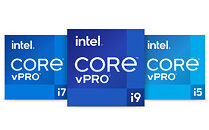


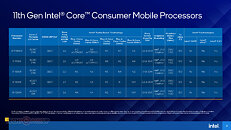

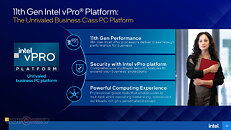
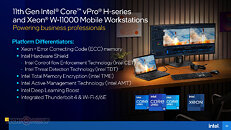

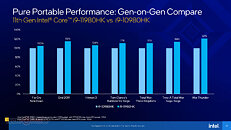

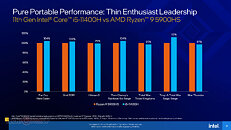


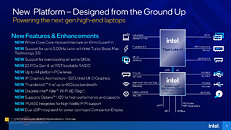
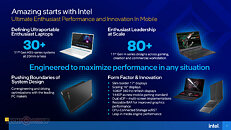

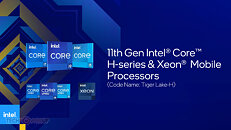

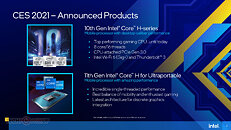

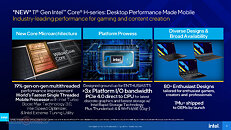
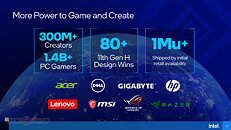

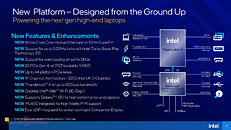






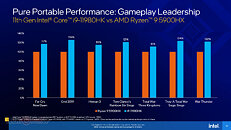




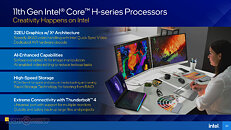




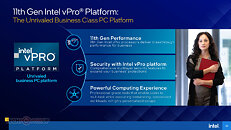
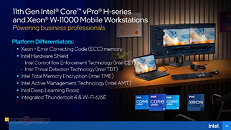
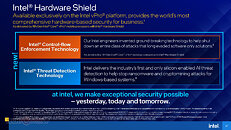



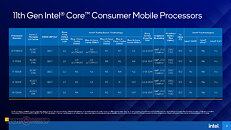





11 Comments on Intel Announces 11th Gen Core "Tiger Lake-H" Mobile Processors
better IO overall, PCIe 4.0 8x on mean 3.0 x16 in term of bandwidth while Ryzen laptop still stuck at 3.0
thunderbolt also nice for content creator laptop
That's a tie, but it's ok. The performance level is already incredible. You'll be basing your buying decision on connectivity and battery life when picking between these two. And, of course, availability.